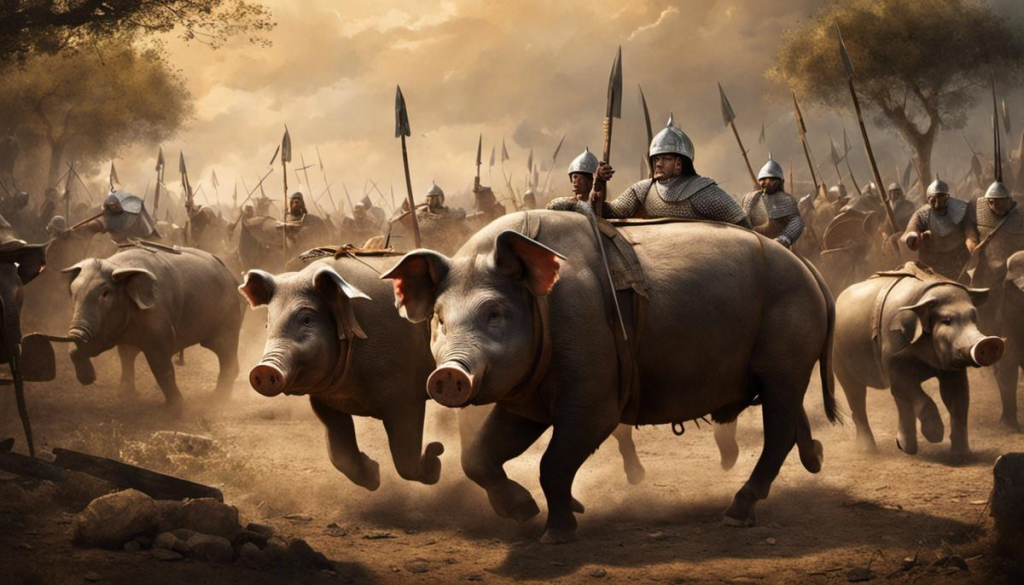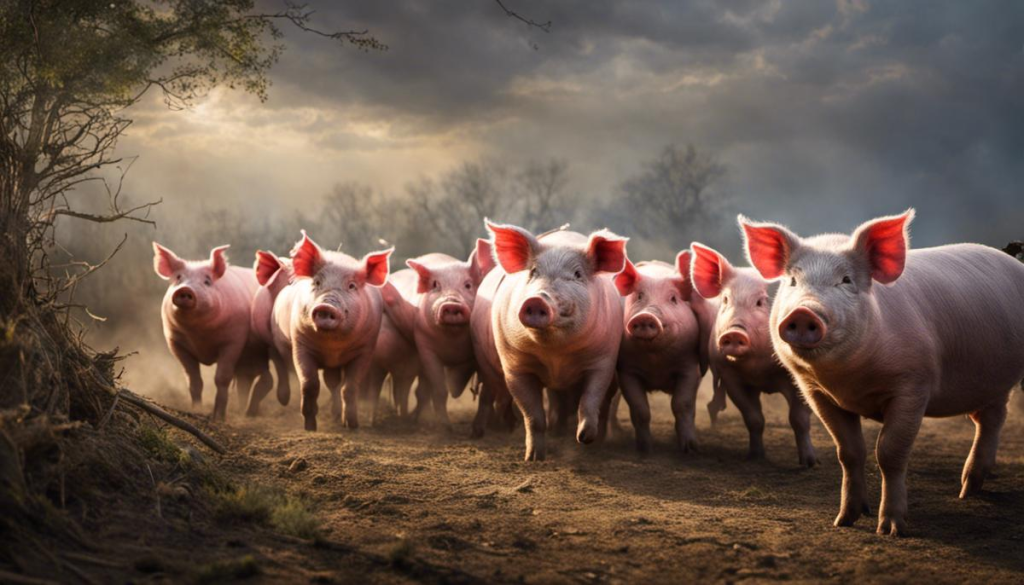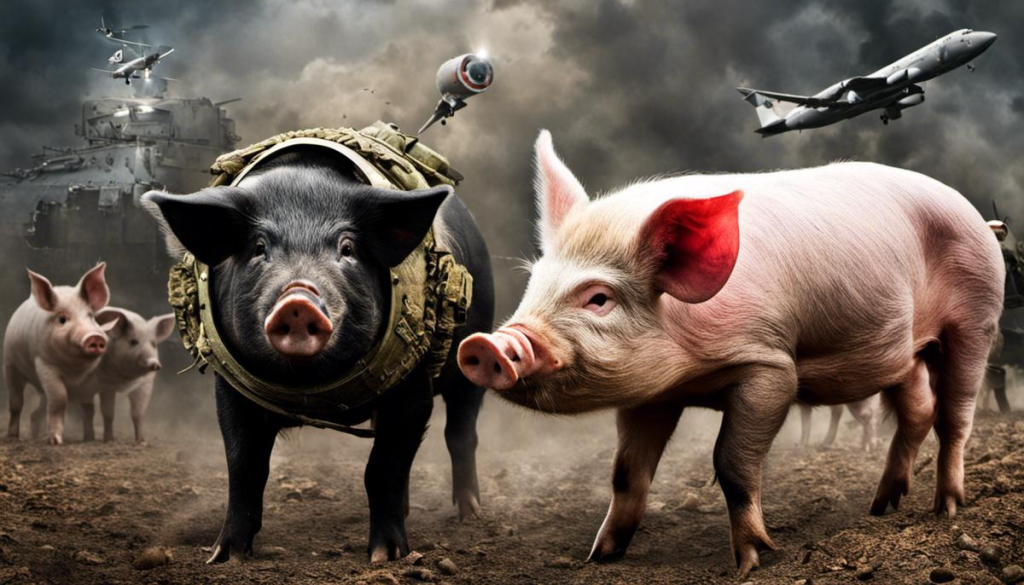When we think of formidable forces used in war, the mind naturally leans towards sophisticated weaponry and well-trained soldiers. Yet, in the pages of history, one finds fascinating narratives that defy these conventional expectations. Among them is the rather unconventional deployment of pigs in warfare which played in a far-reaching capacity beyond the thresholds of the obvious. Dating back to the times of classical antiquity, pigs were used not only as a tactical countermeasure against war elephants but also assumed profound sociocultural significance. Fast forwarding to the present day, pigs continue to hold their place in military tradition as mascots, while also posing potent risks in the realm of biological warfare. Thus, this multi-layered association between pigs and warfare is as intriguing as it is complex, shedding light on an aspect that underscores the evolving strategies and dynamics of war.

Ancient use of pigs in warfare
Ancient Use of Pigs in Warfare: A Unique Countermeasure
As far back as the classical era of antiquity, combatants discovered a unique method of warfare – the use of pigs. In the heat of battle, these seemingly unsuspecting animals were employed for strategic purposes to gain the upper hand. One of their most significant roles was as a countermeasure against the mighty war elephants seen on various battlefields during this period.
Romans, Greeks and Carthaginians: The Pioneers of Porcine Warfare
Perhaps some of the most notable examples of employing pigs in warfare can be traced to the wars involving powers like the Romans, Greeks, and Carthaginians. These civilizations unlocked the potential of pigs as formidable tools in combat, particularly when rival armies featured war elephants, a then-common feature of the armories of ancient powers.
Pigs vs Elephants: A Battle of Instincts
The primary reason behind using pigs against war elephants stemmed from a deeply ingrained fear that elephants had towards the smaller creatures. Despite their immense size, power, and potential for destruction, elephants could be panicked by the squeal of a pig. Incensed and terrified by the noise, the elephants would thrash uncontrollably, causing destruction and havoc within their own ranks rather than those of the enemy.
Fiery Hogs: The Weapon of Choice
The Greeks and Romans resorting to a fascinating yet brutal method in these situations – the use of what they termed ‘fiery pigs’ or ‘war pigs.’ These were pigs covered in pitch, resin, or another flammable substance, then ignited and released onto the battlefield aimed directly at enemy lines housing war elephants.
Historical Accounts: Pig Warfare in Illustrations
The historian Aelian (De Natura Animalium, book XVI) chronicles an incident during 275 BC when the army of Antigonus II Gonatas, the king of Macedon, turned away war elephants using squealing pigs. Roman legions also reportedly used pigs in the siege of Megara in 266 BC. These accounts offer vivid illustrations of how warfare used unconventional tactics, sometimes turning the tide in favour of the less conventional party.
From Greek Warfare to Asian Conflicts
The use of pigs in warfare was not limited to the Greeks and Romans. Historical narratives from India, Southeast Asia, and the Middle East also tell tales of armies unleashing the wrath of war pigs against their enemies, underscoring the wide prevalence of this strategic tactic across multiple continents.
Pigs in Warfare: An Overlooked Piece of History
When we think about warfare, pigs may not be the first thing that comes to mind. Advances in technology and strategies have pushed this ancient tactic into the shadows of obscurity. However, the historical use of pigs in battle holds valuable lessons in ingenuity and adaptability. Their role in conflict and warfare mesmerizes historians, military theorists, and those curious about the evolution of warfare from ancient times to the present day, proving that pigs’ contribution to history is far from insignificant.

Socio-cultural implications of using pigs in war
The Cultural and Religious Implications of Pig-Based Warfare
In many societies, pigs play a significant role, either through sacred reverence or deep-seated taboos. Cultural norms and principles could be disrupted and cause tension in societies that used pigs in warfare due to these associations. For example, in certain Polynesian traditions, the pig symbolizes wealth and prestigious status, integral to various ceremonies and gatherings. Therefore, their use in warfare could jeopardize these traditions, potentially causing significant cultural upheaval.
Conversely, in religious groups such as Jews and Muslims, pigs are considered taboo. Utilizing pigs in warfare could be interpreted as a sacrilegious act, causing unrest and escalating conflicts within these societies. The potential disruption to social structures could lead to profound and damaging repercussions.
In faiths like Hinduism, which advocates for ahimsa or non-violence towards all living beings, the use of any animal in warfare is seen as a flagrant breach of this tenet. Hence, employing pigs or any other animal in warfare is considered a significant violation of their religious principles.
Psychological Impact of Pigs in Warfare
Pigs’ presence on the battlefield has psychological implications for soldiers and civilians alike. This effect can be highly varied, depending largely on individuals’ environmental predispositions and cultural or religious beliefs about pigs. In certain circumstances, the use of pigs may instill fear or revulsion due to their associations with filth or as carriers of diseases – both views prevalent in various cultures to varying degrees.
Moreover, the maltreatment or weaponization of animals, including pigs, in warfare, could lead to increased distress among soldiers, potentially exacerbating post-traumatic stress disorder (PTSD) or other war-related mental health issues. This could also lead to broader societal changes, as soldiers return home with heightened psychological stress, impacting their families and communities.
From a broader societal perspective, the use of pigs in warfare may foster negative perceptions of the military or government institutions responsible for such actions. This could lead to public disapproval, resistance, or even mass protests, particularly in societies where animal rights are highly valued. Consequently, the use of pigs in warfare could lead to societal tension and division – adding a layer of complexity to the socio-cultural landscape within these communities.
Conversely, the use of pigs in warfare can result in dehumanizing the enemy, especially if the opponent views pigs as unclean or unfavorably. This strategy can influence the warfare approach making it a psychological warfare and disturb the morale of the enemy troops.
Pigs in Warfare: The Sociocultural Impact
Historically, the engagement of pigs in warfare has indeed led to significant alterations in societal practices and traditions. This is especially true in cultures where pigs play an integral part. Events such as pig rearing, pig festivals, and pig sacrifices could suffer disruption or even complete abolition due to the necessity of diverting these animals into the theatre of war.
The shifts may interfere with established societal norms and practices, and potentially lead to changes in social identity and cohesion. As a result, this could provoke broader societal alterations in cultural dynamics, unity, and harmony. The regular peaceful association of societies with pigs could be tainted by hostile encounters, culminating in profound societal transformations.

Pigs as military mascots
Pigs as Mascots: A Testament to Their Courage
Pigs, celebrated for their intelligence and extraordinary characteristics such as bravery and tenacity, have often been embraced by military units as mascots – attributes that reflect those sought in soldiers. A striking instance of this involved a pig named Tirpitz. Tirpitz was a full-grown pig aboard the German cruiser SMS Dresden during the naval Battle of the Falkland Islands in World War I. After the vessel’s unfortunate demise, Tirpitz was salvaged by the crew of HMS Glasgow, who subsequently adopted him as their mascot.
Significance of Pigs to Military Units
Pigs as mascots have become akin to spiritual symbols and morale boosters within the ranks of military units. They symbolize resilience and serve to lift the spirits and foster unity among soldiers. For example, Tirpitz, the pig mascot for the HMS Glasgow, became a beloved figure aboard the ship, often participating in official photographs and recollections of events, effectively becoming one of the crew members.
Pigs in Military Tradition and Folklore
Pigs have also found their place in military tradition and folklore. In many military units globally, pigs are considered symbols of good luck or protection against evil. In some societies, ancient warriors took pigs into battle believing they would bring success and protect them from harm. Some units preserve these tales and adopt pigs as their mascots to encapsulate their shared history and foster a sense of camaraderie.
Modern Instances of Military Mascots
In modern times, the use of pigs as military mascots continues, best seen in the examples of Nellis Air Force Base’s mascot, Amelia the Pig, and Chris P. Bacon, the pig mascot for the Ohio Air National Guard 178th Wing. Both these mascots are integral to their respective military units’ traditions and identities, participating in various social and official activities.
The Public Appeal of Animal Mascots
The public appeal of pigs and other animal mascots in the military adds another dimension to their significance. Their stories often capture the public’s attention, introducing a softer, more human side of the military. For example, the story of Tirpitz, the pig mascot of the HMS Glasgow, became a media sensation during World War I. Photos and tales of Tirpitz were widely circulated; he even had a humorous obituary penned for him when he died of old age in 1919.
The Role of Mascots in Military training and Therapy
Beyond serving as symbols and morale boosters, pigs used as military mascots today also contribute significantly to military training programs and therapeutic initiatives. Their interactive nature and intelligence are qualities that can be harnessed in programs aimed at alleviating stress and healing trauma among military personnel. For example, Chris P. Bacon serves the Ohio Air National Guard 178th Wing not just as a mascot but as a therapy pig essential in the unit’s morale, welfare and recreation programs.
The humble pig may not immediately come to mind when considering military mascots, yet its association and significance within the ranks cannot be overlooked. Representing a unique amalgamation of traditional symbolism, morale enhancement, therapeutic healing, and a source of camaraderie, pigs serve to inject an element of humanity into the stern world of the military.

Pigs in biological warfare
The Covert Biological Warfare Agent: Pigs
Curiously, pigs have been employed in conflicts not as conventional combatants, but as concealed carriers of fatal diseases. Historically, the susceptibility of swine to a wide array of bacteria, viruses, and parasites has seen them deployed as unsuspecting vectors in the horrifying theatre of biological warfare.
Swine Diseases in Warfare
Several types of swine diseases can be used as agents in biological warfare. One well-known example is African Swine Fever (ASF), a highly contagious virus that causes hemorrhagic fever in pigs but is harmless to humans. However, if it spreads extensively among swine populations, it can cause catastrophic damage to the agriculture and economy of the enemy territories.
Another example is swine flu, a respiratory disease that can cross the species barrier. The H1N1 virus, which caused a pandemic in 2009, originated in pigs. These diseases, if intentionally released in conflict zones, have the potential to disrupt agriculture and economy, and in some cases, directly impact human health.
Biosecurity Risks
The biosecurity risks associated with using pigs in warfare are significant. Once infectious diseases break out among swine populations, they are difficult to control due to the high reproductive rate and social behavior of pigs. In addition, many diseases that afflict pigs can spread to humans and other animals, potentially exacerbating health crises in conflict areas.
Host-Parasite Relationships: A Complex Scenario
The host-parasite relationship with pigs in the context of warfare is complex. Pigs are an important vector for parasites such as ticks, which can carry a whole other set of diseases. In addition, the stress of warfare can weaken pigs’ immune systems, making them even more susceptible to parasites and diseases. Furthermore, uncontrolled animal populations and unsanitary living conditions can favor the widespread of parasites.
Factors Influencing Pigs’ Role in Warfare
The use of pigs in biological warfare depends on a variety of factors. These include agricultural practices, population density, and the environmental and climate conditions in the area. In regions where pig farming is common, and relevant biosecurity measures are not well-established, the threat posed by swine diseases could be significantly higher.
Preventive Strategies
Contemporary preventive strategies include improved animal health surveillance, vaccination programs, and rigorous biosecurity practices. Additionally, understanding how diseases spread in pig populations and how they can jump to humans is a crucial aspect of preparation and prevention. Collaborative international efforts are key to preventing the use of pigs in biological warfare, through data sharing, research, and establishing common standards for animal health.
Historical Instances
Historically, the use of pigs in warfare was more about psychological impact rather than as a strategy for the spread of diseases. In Ancient wars, their alarming and panic-inducing screams when in distress were used to scare off war elephants. However, in modern warfare, their potential as biological tools poses a more alarming threat that requires serious attention and biosecurity measures.

In light of the diverse roles that pigs have played, it is evident that their association with warfare extends far beyond the confines of battlefields. The integration of pigs in warfare was not merely a strategic maneuver but a socio-cultural construct, embedding symbolic meaning into the fabric of military tradition. These symbolic representations have indeed been woven into military lore, manifesting themselves in the form of mascots and symbols, and extending their influence far beyond the physical realm. As we navigate through lethal and complex biosecurity risks, the potential of pigs as bio-warfare agents reminds us of the intricate web linking animal, human, and environmental health. Thus, the narrative of pigs in warfare is a compelling testament to the dynamic nature of warfare, underlining that the art and science of war are as much a matter of innovation and adaptation as they are about might and power.